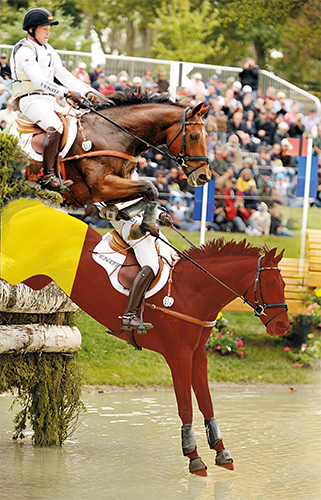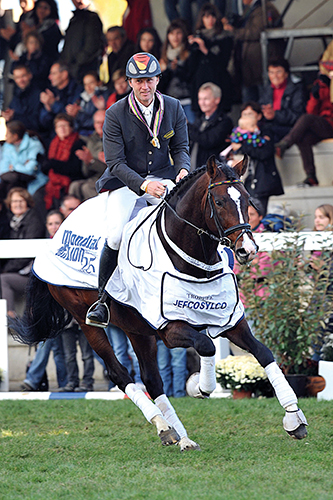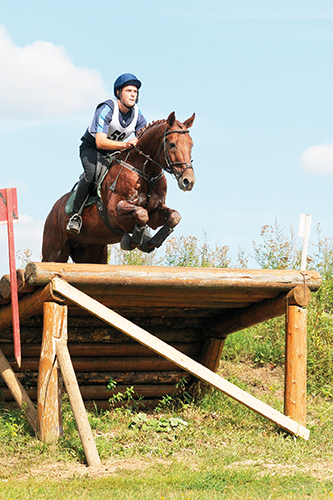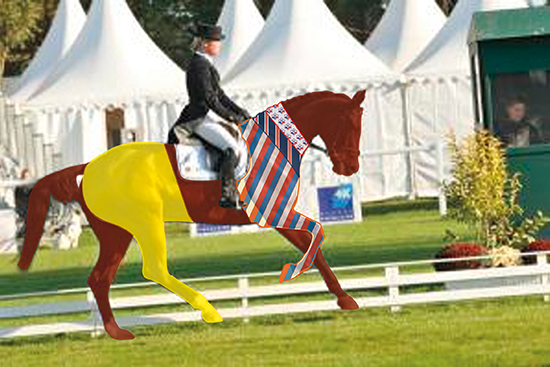Story by Chris Hector and photos by Roz Neave
When the changes in the format for eventing were mooted, there was much discussion of the way in which the new CIC competitions would favor a different type of horse from the more traditional (albeit modified) CCIs. The general feeling was that the CICs would favor the Warmblood bred horses, while the Thoroughbred type would continue to dominate the CCIs.
So let’s look at the most recent World Cup CIC Final Standings and the horses that got their riders there…
Heading the World Cup standings was Michael Jung with 142 points accumulated on two horses, La Biosthetique Sam by Stan the Man xx out of Halla by Heraldik xx and Weidezaunprofi’s River of Joy by Rubicell out of Pagena by Pageno xx. We have already noted that Sam is ¾ Thoroughbred while Michael’s second horse, River of Joy has ‘blood’ on his top line through Angelo xx and Ladykiller xx, and he is out of a mare by the Thoroughbred, Pageno. Since Sam went on to win the World Championship at Lexington over a very testing four star CCI track, it would seem that the same horse can obviously shine in both formats.

Number 1 – La Biosthetique Sam on either formats – CIC and CCI, 75% blood/25% Hanoverian
Second in the World Cup standings was Megan Jones and Kirby Park Irish Jester, home-bred by Megan’s family. Jester is by Irish Enough (a mixture of Thoroughbred, Irish, and perhaps Arab and Percheron blood) out of the Thoroughbred mare Yellow Empress by Fear No Foe. Jester has previously won Adelaide CCI**** and was part of medal-winning teams at both the Aachen WEG and the Beijing Games. The other question that was floated with the introduction of the new format was whether older horses could continue to compete well in CIC competition after their CCI days were gone. Well, we never got to see if Jester’s 16 years were going to count against him in Kentucky.
Flying the horror route from Australia via Hong Kong over Anchorage and into Los Angeles, the gelding started to develop a raised temperature in the LA Quarantine Facility. Incredibly the US authorities refused to allow the Australian vet access to the horses, which meant that he was not routinely hydrated as is our vet’s standard practice. After vigorous Australian protests and finally FEI intervention, the vet was admitted after 12 hours, but by this time the horse had developed a spot in his lung and was pronounced too ill to continue traveling to the WEG.
The horses ridden for the third and fourth riders on the World Cup standings were both Thoroughbreds. Phillip Dutton’s Truluck by Maha Baba out of Grayfully by Full Choke, is straight Thoroughbred with three crosses of Nasrullah and one of My Babu. New Zealander, Clarke Johnstone rode Oaklea Vision (Thoroughbred by Young Indian) and Orient Express, another Thoroughbred, by Blues Traveller out of Oriental Splendour by Runnett, to accumlate his points.
Seven year old World Champion – Mighty Magic. He is by the most beautiful American Thoroughbred, Myrtens who was sold to Britian for $950,000 as a yearling in 1984. He broke down as a two year old training and was sold to those great Dutch jumping breeders. Henk Nijhof and Jan Greve, and proved a brilliant sire of jumpers. Mighty Magic is out of a mare by the great Heraldik out of a mare with two crosses of Landgraf.
Fifth placegetter, Lucy Wiegersma rides a pair of horses that on paper look a more traditional ‘Warmblood’ mix. Woodfalls Inigo Jones is by a Dutch stallion Dex, whose pedigree features a couple of older, heavier type Holstein stallions, Nimmerdor and Amor. Her other points-getter is Granntevka Prince by Grannex – again a slightly old fashioned mix of Grannus and Landgraf – out of Showgirl Ditton Wood by the Thoroughbred, Prince of Peace. However both horses have impressive form in the longer format.
At this year’s Luhmühlen four star, Inigo Jones was 6th and Granntevka Prince, 9th. Last year Granntevka Prince won Blenheim CCI three star and was fourth at Pau CCI****. Woodfalls Inigo Jones was fifth at Lexington CCI****. They are hardly CIC specialists
.
The sixth place went to the Russian rider, Alexey Korshunov riding a pair of Budjonnian horses: Gavot and Fort by Fantsticheskiy out of Rogatka by Rancho.
The Budyonny breed was named after the Bolshevik cavalry commander, Marshall Semyon Budyonny. The breeding began in the early 1920s in the Rostov region of Russia with the intent of producing cavalry horses to replace those lost during World War I. The horses were used in Russian cavalry divisions during World War II and after.
Bred for Russian cavalry – oh well the French do call eventing the Military! Gavotte and Alexey Korshunov
Budyonnys were based on a cross of local Don and Chernomor mares and Thoroughbred stallions. The Chernomor is a type of Cossack horse similar to the Don, although smaller. The young stock were tested for performance on the racecourse and in cavalry equitation courses. In 1949 the breed was officially recognized. The Budyonny has been used as an all-round competition horse, competing in dressage, steeplechasing, three-day eventing, and endurance, so again it would seem that we are dealing with a familiar mix of Thoroughbred over local breeds.
In seventh place we find Andreas Dibowski with Euroridings Butts Leon by Heraldik out of Lillian by Star Regent, as has been noted many times, the horses bred by Mr Butt bear the Hanvoerian brand but are 63/64ths Thoroughbred blood. Once again this is a horse that has no problems switching from winning a team gold medal at the Beijing Games to World Cup competition and back again, although Andreas’ cross country run at Lexington is perhaps one he would rather forget. Dibowski’s other points earner was another Hanoverian, FRH Fantasia by a somewhat old fashioned stallion, Federweisser (a Werther grandson out of a Lungau mare) out of Quiena by the Selle Français, Quasi Roi (by the Anglo Arab, Hadj A out of a mare by Quastor by Ibrahim). Once again, there is plenty of ‘blood’ to leaven the Warmblood mix, and she went on to win Pau four star to prove she can handle a CCI.
Another German, Kai Rüder held down 8th spot. He rode the Trakehner, TSF Karascada M by Heraldik xx out of Karatschi II by Anduc. The mare was 8th at Lumühlen **** in 2008, and went clear clear at Badminton in 2009 to haul herself up 28 places, and finish in 23rd. Obviously four star cross country is not her problem. Kai also placed in the CICs on Saaten-Unions Charlie Weld a Hanoverian by Connery out of Soraya by
Spartan.

Mrs Medicott, six year old World Young Eventer Champion, 25% Hanoverian, 25% Holsteiner, 6.25% Anglo Arabian, another 6.25% Selle Français then the remainder 37.5% and the greatest proportion, Thoroughbred
In ninth, another German, Dirk Schrade riding a French horse, the Anglo Arab, Gadget de la Cere by Athos de Ceran out of Samanda by Samuel. This horse has had most success over the past two years in the CIC format, with the only CCI placing an 8th at Boekelo three star in 2009. All his other placings were CIC, and he spectacularly failed to finish the cross country at the WEG in Lexington.
Tenth to Australia’s Sonja Johnson and Ringwould Jaguar, a horse that has shone in both formats at the highest level. He is by the Quarter horse stallion, Jensens Man (but with a running Quarter horse sire, so lots of Thoroughbred there) out of the Thoroughbred mare, Nations of Lili’s by Carnation for Me out of a Wateringbury mare. This horse finished the cross country at Lexington clear with 7.6 time but was found to have a puncture wound in his fetlock, and was unable to continue, but at the age of 18 he seemed to have answered the ‘can older horses still compete
CCI?’ query.
I guess the above proves that we have not witnessed the emergence of specialist CIC or CCI horses, with the changes to the eventing format. I suspect the only place where Warmblood breeding is starting to predominate is in the ranks of the Young Eventer classes.
In the six year old World Young Eventer championship at Lion d’Angers, looking at both the sires and dam sires of the entrants, we find fourteen Thoroughbreds out of a possible 82. In the seven year old class, just 17 out of a possible 132. Now this is pretty superficial, if I went and chased all the pedigrees through a generation or three, no doubt I’d find more ‘xx’s, but the proportion of up close Thoroughbred breeding is far lower than it is at either the World Cup Final level, or at the WEG level. Certainly, it’s my feeling at the young event horse classes that I have seen, that it is much easier to see flashy dressage movement or stylish form over a fence, much harder to detect that magic quality that makes for a great cross country round…
The proportion of Thoroughbred blood increases if we look at the top ten placegetters and when we move from the six year old class to the seven year old class where the cross country can be a little more testing. Of the top ten in the six year old championship, 5 out of twenty, sires or dam sires, were Thoroughbred. In the seven year old class, it was 7 out of twenty.
The Thoroughbred can confidently echo Mark Twain’s cable to the newspaper that published his premature obituary: The reports of my death are greatly exaggerated…
This article first appeared in the March 2011 issue of THM.



